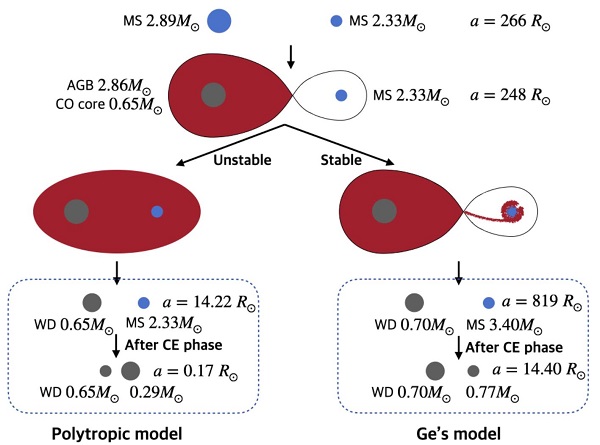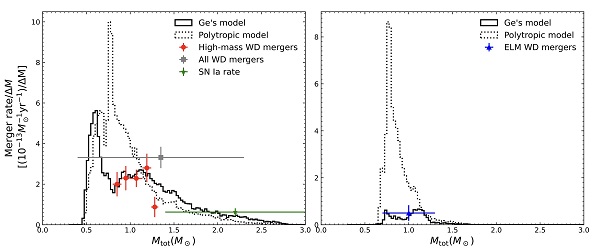Recently, Dr. LI Zhenwei and his collaborators from Yunnan Observatories, Chinese Academy of Sciences (CAS), reported the latest progress on double white dwarf (DWD) populations in the Galaxy. This work was published in Astronomy and Astrophysics.
The DWDs are of great importance in astrophysics. The merger of DWDs can produce type Ia supernova (one of the two mainstream models of type Ia supernovae). Close DWDs are the main detectable sources for future space-based gravitational-waves detectors, such as Laser Interferometer Space Antenna (LISA), TianQin and TaiJi.
DWDs are produced from binary evolution processes. However, the orbital parameters of some observed DWDs cannot be reproduced according to the previous criterion of mass transfer stability from the polytropic models. Recently, Ge et al. obtained the new mass transfer stability by adopting the adiabatic mass loss model. (hereafter Ge’ s model). The new mass transfer stability would have significant effects on the properties of DWDs (as shown in Figure 1). Preliminary results are achieved in the study of type Ia supernova and binary black holes by using this criterion.
The researchers performed a series of binary population synthesis with adopting the new mass transfer stability criterion, and found that the merger rate distribution in the observations can be well reproduced in Ge’ s model (as shown in Figure 2) without any tuning of parameters. They confirmed that mass transfer stability plays an important role in the formation and properties of DWD populations. The results from Ge’ s model support the observations better than what can be derived from the polytropic model.
Contact:
LI Zhenwei
Yunnan Observatories, CAS
Email: lizw@ynao.ac.cn

Fig 1: Examples for the formation of double white dwarfs from different mass transfer stability criteria. MS -- main sequence, AGB -- asymptotic giant branch, WD -- white dwarf, CE -- common envelope.

Fig 2: The merger rate distribution of double white dwarfs. The left panel is for all double white dwarfs, the right panel is for double white dwarfs with extremely low-mass white dwarf (ELM WD) companions.